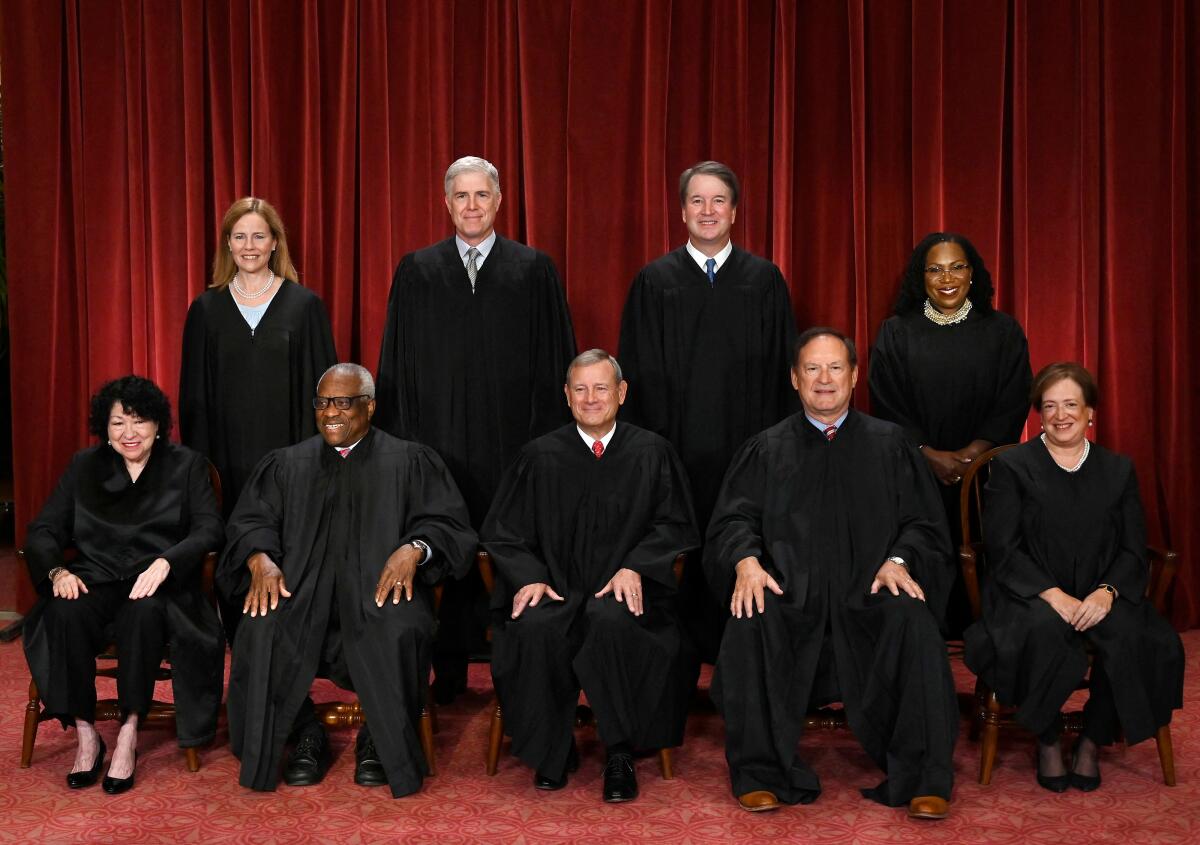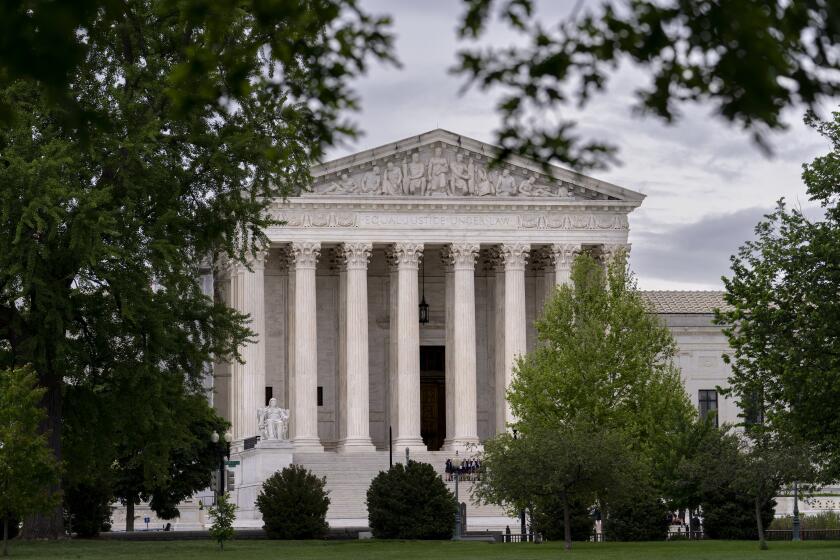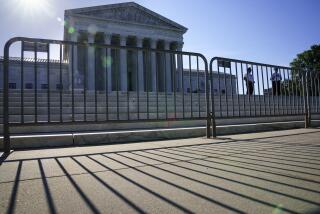Supreme Court’s conservatives are solidly in control, but not quite as predictable as last year

- Share via
WASHINGTON — The Supreme Court’s conservatives were solidly in control as they ended this year’s term with major rulings against college affirmative action and President Biden’s student loan forgiveness plan while upholding a Christian web designer’s right to refuse work involving gay marriages.
All six conservatives were in the majority in those rulings, while the three liberals dissented. It looked like a replay of last year when the court overturned the right to abortion and expanded gun rights.
But for much of rest of the term, the justices sounded a different note.
They were not quite as predictable or as aggressively activist as some on the right would prefer and many on the left feared. The old-fashioned conservative virtues of restraint and moderation reappeared at times.
They voted for the status quo on voting rights, elections and immigration enforcement. And they steered away from what Justice Neil M. Gorsuch referred to as “government by lawsuit.”
The two most frequent dissenters for most of the year were not its liberals, but Justices Clarence Thomas and Samuel A. Alito Jr., the two who occupy the court’s right flank.
They have been in the spotlight because of their free and undisclosed vacation trips with billionaire Republican donors. Perhaps it is no coincidence their colleagues were glad to separate from them this year.
Over their dissents, the justices rejected Alabama’s challenge to the Voting Rights Act and its commitment to giving Black voters a chance to elect a representative of their choice. They dismissed a potentially sweeping GOP claim that partisan state lawmakers had unchecked power over the elections for members of Congress and the president.
They rejected lawsuits from Texas state attorneys seeking to block Biden’s immigration enforcement plan.
They upheld a California animal welfare law against a lawsuit brought by Midwest hog farmers. And they kicked out a lawsuit from the Texas state attorneys to strike down the Indian Child Welfare Act that seeks to keep Native children with tribal families.
In their most significant emergency order, they voted in April to put an indefinite hold on a ruling that would have overruled the Food and Drug Administration and taken abortion pills off the market.
Antiabortion groups had sued before a conservative judge in Amarillo, Texas, contending abortion pills were dangerous, and they had won there.
But the Biden administration appealed, and the high court blocked the ruling from taking effect. Alito and Thomas dissented.
Why the change from last year on so many fronts?
One explanation might be that the justices, or at least some of them, were shaken by the public reaction to the rulings last summer, particularly the overturning of the landmark abortion ruling Roe vs. Wade.
For months, the court itself appeared to be under siege. The building was closed to the public and surrounded by high metal fences. There were heightened worries about security, especially after a California man carrying a gun was arrested outside of the home of Justice Brett M. Kavanaugh.
In the evenings, protesters regularly marched and chanted outside the homes of the conservative justices. That, too, continued for months.
In public comments, Chief Justice John G. Roberts Jr. and Alito bristled at the suggestion that the right-leaning court lacked “legitimacy.”
You may disagree with our decisions, they said, but do not accuse the justices of being driven by politics, not law.
The public’s view of the Supreme Court remains at a low ebb as the justices prepare to issue their most important decisions of the year. Term limits won’t solve all of the court’s problems, but they could help.
In opinion polls, most Americans are not convinced. They said they think the court is driven by politics, not law.
Justice Elena Kagan, a liberal dissenter from last year, took her dissents public and agreed with the critics. Speaking at several legal conferences, she said the court had itself to blame.
“The way the court retains its legitimacy and fosters public confidence is by acting like a court,” she said, not by doing things “that seem to people political or partisan.”
When the new term opened last fall, several justices said they were looking forward to a quieter year.
For their part, the justices see themselves as serious-minded jurists guided by law, not ideologues or partisans. They often talk about how they are unanimous or nearly so in deciding a large percentage of their cases. Unlike in the House and Senate, compromise and working out disagreements is still seen as a virtue at the court.
No single justice was responsible for the apparent shift to the middle in several key cases.
The chief justice took the lead in the voting rights and election cases, and Kavanaugh cast a key vote to join him.
Kavanaugh and Justice Amy Coney Barrett wrote opinions throwing out two Texas cases based on standing.
And Gorsuch spoke for the court, joined crucially by Barrett, to uphold California’s animal welfare law.
Despite all that, the term ended once again with the justices fiercely divided along ideological lines. On the issues of race and religion, they have strongly held views, and there is no middle ground.
On affirmative action, they wrote opinions, concurrences and dissents that ran to 237 pages.
Thomas and Jackson, the court’s two Black justices, delved deeply into American history and came to opposite conclusions.
Thomas said the 14th Amendment made Americans equal under the law without regard to race, while Jackson said the Reconstruction amendments aimed to overcome the legacy of slavery by helping Black people achieve equality.
On Friday, Roberts and Kagan argued back-and-forth over whether Biden was following the law or breaking it by promising to forgive student loans in the wake of the COVID-19 national emergency.
But when the gavel sounded, it was time for the justices to head off for a summer recess.
More to Read
Get the L.A. Times Politics newsletter
Deeply reported insights into legislation, politics and policy from Sacramento, Washington and beyond. In your inbox three times per week.
You may occasionally receive promotional content from the Los Angeles Times.












